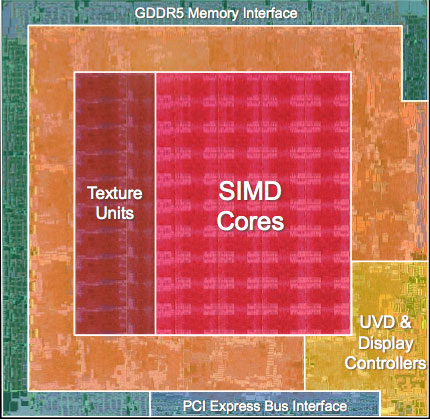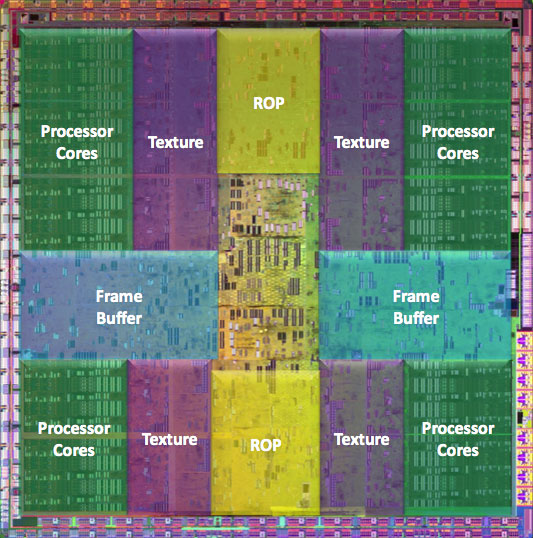The Radeon HD 4850 & 4870: AMD Wins at $199 and $299
by Anand Lal Shimpi & Derek Wilson on June 25, 2008 12:00 AM EST- Posted in
- GPUs
Wrapping Up the Architecture and Efficiency Discussion
Engineering is all about tradeoffs and balance. The choice to increase capability in one area may decrease capability in another. The addition of a feature may not be worth the cost of including it. In the worst case, as Intel found with NetBurst, an architecture may inherently flawed and a starting over down an entirely different path might be the best solution.
We are at a point where there are quite a number of similarities between NVIDIA and AMD hardware. They both require maintaining a huge number of threads in flight to hide memory and instruction latency. They both manage threads in large blocks of threads that share context. Caching, coalescing memory reads and writes, and handling resource allocation need to be carefully managed in order to keep the execution units fed. Both GT200 and RV770 execute branches via dynamic predication of direction a thread does not branch (meaning if a thread in a warp or wavefront branches differently from others, all threads in that group must execute both code paths). Both share instruction and constant caches across hardware that is SIMD in nature servicing multiple threads in one context in order to effect hardware that fits the SPMD (single program multiple data) programming model.
But the hearts of GT200 and RV770, the SPA (Steaming Processor Array) and the DPP (Data Parallel Processing) Array, respectively, are quite different. The explicitly scalar one operation per thread at a time approach that NVIDIA has taken is quite different from the 5 wide VLIW approach AMD has packed into their architecture. Both of them are SIMD in nature, but NVIDIA is more like S(operation)MD and AMD is S(VLIW)MD.

AMD's RV770, all built up and pretty
Filling the execution units of each to capacity is a challenge but looks to be more consistent on NVIDIA hardware, while in the cases where AMD hardware is used effectively (like Bioshock) we see that RV770 surpasses GTX 280 in not only performance but power efficiency as well. Area efficiency is completely owned by AMD, which means that their cost for performance delivered is lower than NVIDIA's (in terms of manufacturing -- R&D is a whole other story) since smaller ICs mean cheaper to produce parts.

NVIDIA's GT200, in all its daunting glory
While shader/kernel length isn't as important on GT200 (except that the ratio of FP and especially multiply-add operations to other code needs to be high to extract high levels of performance), longer programs are easier for AMD's compiler to extract ILP from. Both RV770 and GT200 must balance thread issue with resource usage, but RV770 can leverage higher performance in situations where ILP can be extracted from shader/kernel code which could also help in situations where the GT200 would not be able to hide latency well.
We believe based on information found on the CUDA forums and from some of our readers that G80's SPs have about a 22 stage pipeline and that GT200 is also likely deeply piped, and while AMD has told us that their pipeline is significantly shorter than this they wouldn't tell us how long it actually is. Regardless, a shorter pipeline and the ability to execute one wavefront over multiple scheduling cycles means massive amounts of TLP isn't needed just to cover instruction latency. Yes massive amounts of TLP are needed to cover memory latency, but shader programs with lots of internal compute can also help to do this on RV770.
All of this adds up to the fact that, despite the advent of DX10 and the fact that both of these architectures are very good at executing large numbers of independent threads very quickly, getting the most out of GT200 and RV770 requires vastly different approaches in some cases. Long shaders can benefit RV770 due to increased ILP that can be extracted, while the increased resource use of long shaders may mean less threads can be issued on GT200 causing lowered performance. Of course going the other direction would have the opposite effect. Caches and resource availability/management are different, meaning that tradeoffs and choices must be made in when and how data is fetched and used. Fixed function resources are different and optimization of the usage of things like texture filters and the impact of the different setup engines can have a large (and differing with architecture) impact on performance.
We still haven't gotten to the point where we can write simple shader code that just does what we want it to do and expect it to perform perfectly everywhere. Right now it seems like typical usage models favor GT200, while relative performance can vary wildly on RV770 depending on how well the code fits the hardware. G80 (and thus NVIDIA's architecture) did have a lead in the industry for months before R600 hit the scene, and it wasn't until RV670 that AMD had a real competitor in the market place. This could be part of the reason we are seeing fewer titles benefiting from the massive amount of compute available on AMD hardware. But with this launch, AMD has solidified their place in the market (as we will see the 4800 series offers a lot of value), and it will be very interesting to see what happens going forward.










215 Comments
View All Comments
0g1 - Wednesday, June 25, 2008 - link
In the article it says the GT200 doesn't need to do ILP. It only has 10 threads. Each of those threads needs ILP for each of the SP's. The problem with AMD's approach is each SP has 5 units and is aimed directly at processing x,y,z,w matrix style operations. Doing purely scalar operations on AMD's SP's would be only using 1 out of the 5 units. So, if you want to get the most out of AMD's shaders, you should be doing vector calculations.DerekWilson - Wednesday, June 25, 2008 - link
The GT200 doesn't worry with ILP at all.a single thread doesn't run width wise across all execution units. instead different threads execute the exact same single scalar op on their own unique bit of data (there is only one program counter per SM for a context). this is all TLP (thread level parallelism) and not ILP.
AMD's compiler can pack multiple scalar ops into a 5-wide VLIW operation.
on purely scalar code with many independent ops in a long program, AMD can fill all their units and get close to peak performance. explicit vector instructions are not necessary.
gigahertz20 - Wednesday, June 25, 2008 - link
http://www.hardwarecanucks.com/forum/hardware-canu...">http://www.hardwarecanucks.com/forum/ha...870-512m...The site above mounted an after market cooler on it and got awesome results. Either the Thermalright HR-03 GT is just that great of a GPU cooler, or the standard heatsink/fan on the 4870 is just that horrible. Going from 82C to 43C at load and 55C to 33C at idle, just from an after market cooler is crazy! I was hoping to see some overclocking scores after they mounted the Thermalright on it, but nope :(
Matt Campbell - Wednesday, June 25, 2008 - link
The HR-03GT really is that great. Check it out: http://www.anandtech.com/casecoolingpsus/showdoc.a...">http://www.anandtech.com/casecoolingpsus/showdoc.a...Our 8800GT went from 81 deg. C to 38 deg. C at load, 52 to 32 at idle. That's also with the quietest fan on the market at low speed. And FWIW, I played through all of The Witcher (about 60 hours) with the 8800GT passively cooled in a case with only 1 120mm fan.
-Matt
Clauzii - Wednesday, June 25, 2008 - link
I see no fan on that thing??! PASSIVE?? :O ??jeffreybt2 - Wednesday, June 25, 2008 - link
"Please note that this is with a single Zalman 92MM fan operating at 1600RPM along with Arctic Cooling MX-2 applied to the base."magnusr - Wednesday, June 25, 2008 - link
Does the audio part of the card support PAP? If not all blu-ray audio will be downsampled to 16/48...NullSubroutine - Wednesday, June 25, 2008 - link
I would just like to point out that the 4870 falls behind the 3870 X2 in Oblivion while in every other game it runs circles around it. To me it appears to be a driver problem with Oblivion rather than an indication of the hardware not doing well there. Unless of course the answer lies in the ring bus of the R680?orionmgomg - Wednesday, June 25, 2008 - link
I would love to see more benchmarks with the CPU OCed to at least 4.0All the CPUs you use can hit it NP.
Also, what about at least 2 GTX 280 Cards and their numbers. Noticed that you did have them in SLI cause the power comsumption comparisons had them, but you held back the performance numbers...
Lets see the top 4 cards from ATI and Nvidia compete in dule GPU (no punt intended)on an X48 with DDR3 1600 and a FSB of 400x10!
That would be really nice for the people hoe have performance systems, but may still be rocking out a pair of EVGA 8800Ultras, cause their waiting for real numbers and performance to come out - and their still paying off theye systems lol... :]
Ilmarin - Wednesday, June 25, 2008 - link
You're probably aware of these already, but I'll mention them just in case:* Page 10 (AA comparison) is malformed with no images
* Page 21 (Power, Heat and Noise) is missing the Heat and Noise stuff.
Heat is a big issue with these 4800 cards and their reference coolers, so it would be good to see it covered in detail. My 7800 GTX used to artifact and cause crashes when it hit 79 degrees, before I replaced it with an aftermarket cooler. Apparently the 4870 hits well over 90 degrees at load, and the 4850 isn't much better. Decent aftermarket coolers (HR-03 GT, DuOrb) aren't cheap... and if that's what it takes to prevent heat problems on these cards, some people might consider buying a slower card (like a 9800 GTX+) just because it has better cooling.
Anand, you guys should do a meltdown test... pit the 9800 GTX+ against the 4850, and the 4870 against the GTX 260, all with reference coolers, in a standard air-cooled system at a typical ambient temp. Forget timedemos/benchmarks... play an intensive game like Crysis for an hour or two, and see if you encounter glitches and crashes. If the 4800 cards can somehow remain artifact/crash free at those high temps, then I'd more seriously consider buying one. Heat damage over time may also be a concern, but is hard to test for.
Sure, DAAMIT's partners will eventually put non-reference coolers on some cards, but history tells us that the majority of the market in the first few months will be stock-cooled cards, so this has got be of concern to consumers... especially early adopters.